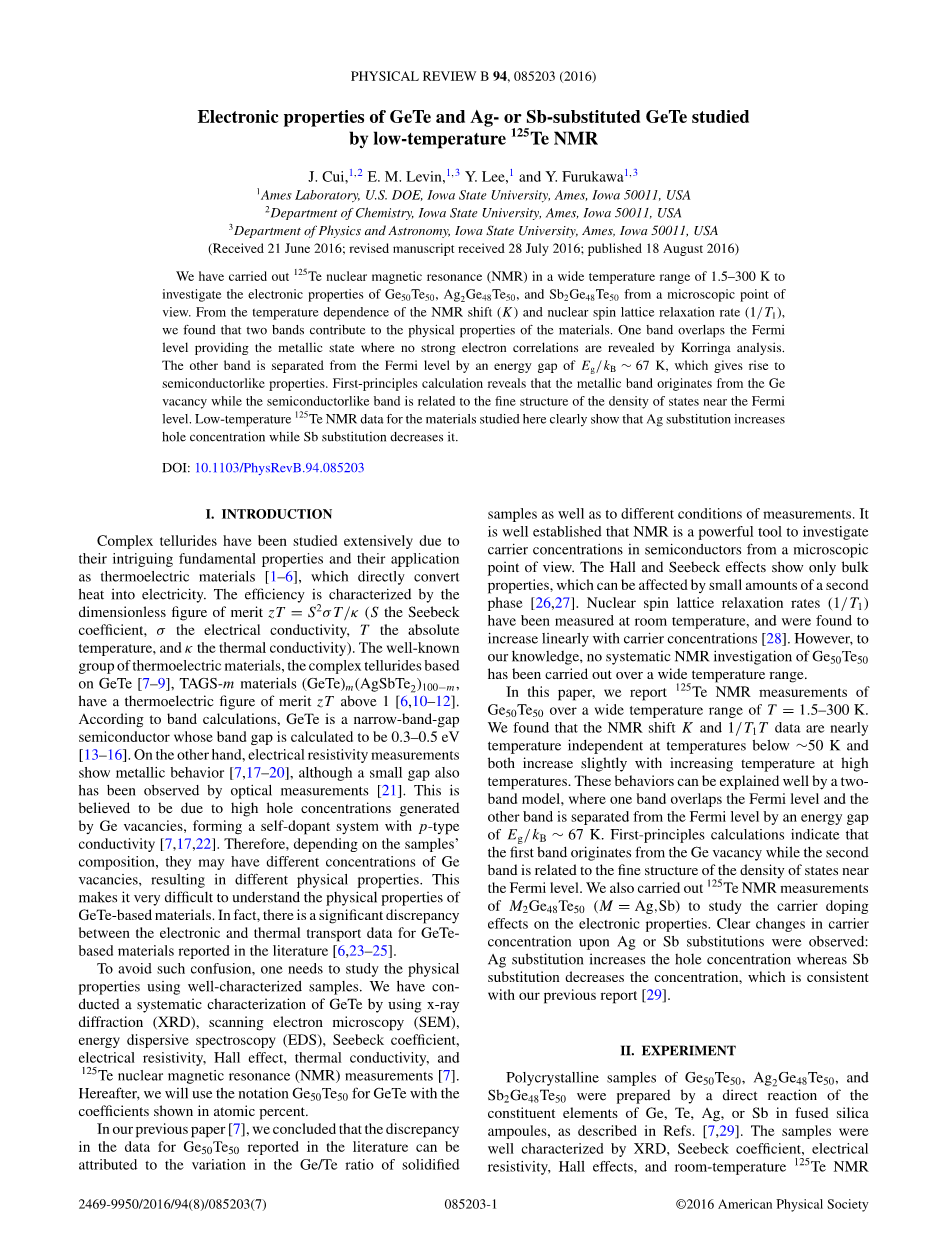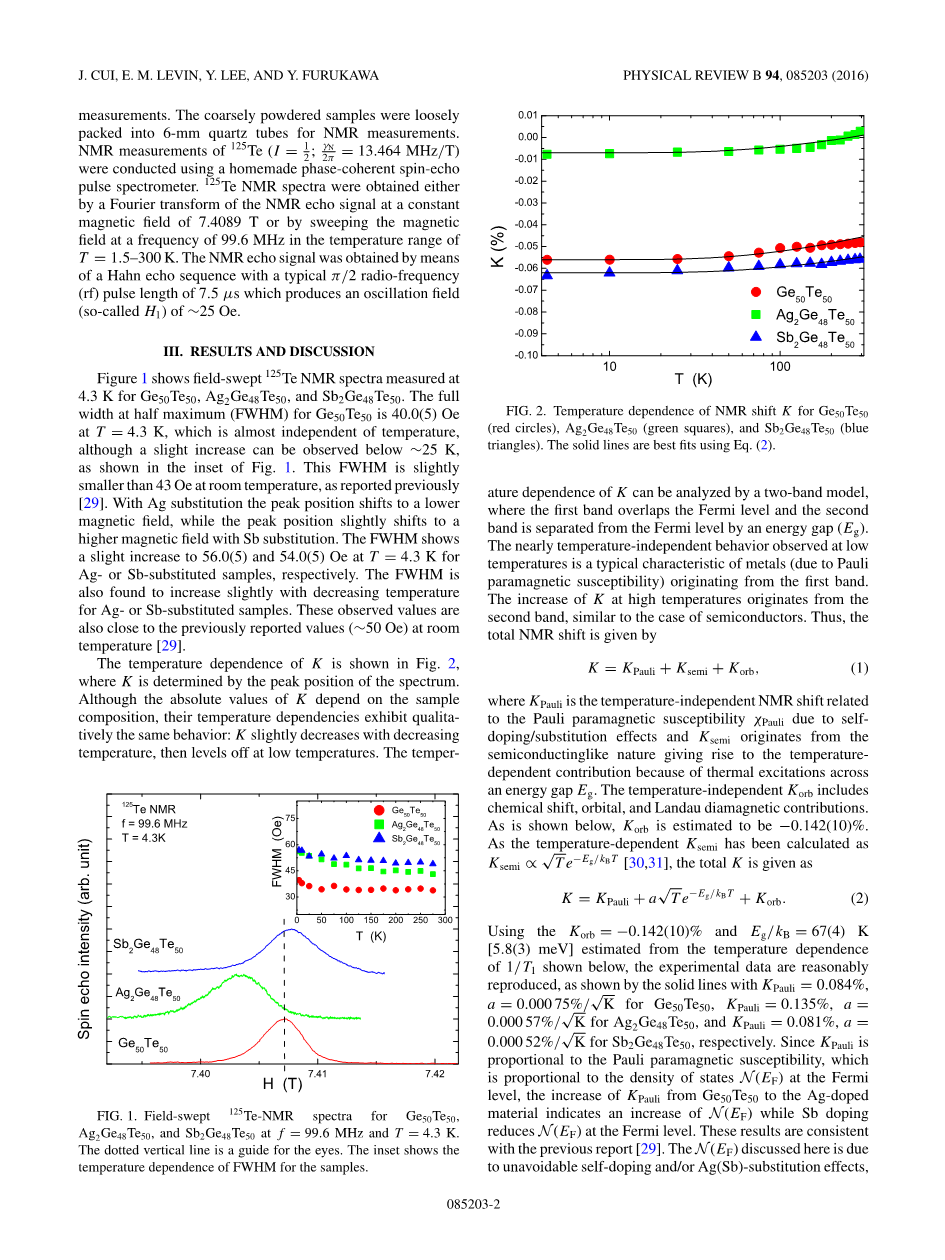固体核磁共振的原理及其在磁性材料中的应用外文翻译资料
2022-12-29 11:44:32
本科毕业设计(论文)
外文翻译
Electronic properties of GeTe and Ag- or Sb-substituted GeTe studied by low-temperature 125Te NMR
作者:J. Cui,1,2 E. M. Levin,1,3 Y. Lee,1 and Y. Furukawa1,3
国籍:1.Ames Laboratory, U.S. DOE, Iowa State University, Ames, Iowa 50011, USA.2.Department of Chemistry, Iowa State University, Ames, Iowa 50011, USA 3.Department of Physics and Astronomy, Iowa State University, Ames, Iowa 50011, USA
出处:PHYSICAL REVIEW B 94, 085203 (2016)
原文正文:
I. INTRODUCTION
Complex tellurides have been studied extensively due to their intriguing fundamental properties and their application as thermoelectric materials, which directly convertheat into electricity. The efficiency is characterized by the dimensionless figure of merit zT = S2sigma;T/kappa; (S the See beck coefficient, sigma; the electrical conductivity, T the absolute temperature, and kappa; the thermal conductivity). The well-known group of thermoelectric materials, the complex tellurides based on GeTe, TAGS-m materials (GeTe)m(AgSbTe2)100minus;m, have a thermoelectric figure of merit zT above 1. According to band calculations, GeTe is a narrow-band-gap semiconductor whose band gap is calculated to be 0.3–0.5 eV. On the other hand, electrical resistivity measurements show metallic behavior, although a small gap also has been observed by optical measurements. This is believed to be due to high hole concentrations generated by Ge vacancies, forming a self-dopant system with p-type conductivity. Therefore, depending on the samplesrsquo; composition, they may have different concentrations of Ge vacancies, resulting in different physical properties. This makes it very difficult to understand the physical properties of GeTe-based materials. In fact, there is a significant discrepancy between the electronic and thermal transport data for GeTe based materials reported in the literature.
To avoid such confusion, one needs to study the physical properties using well-characterized samples. We have conducted a systematic characterization of GeTe by using x-ray diffraction (XRD), scanning electron microscopy (SEM), energy dispersive spectroscopy (EDS), See beck coefficient, electrical resistivity, Hall effect, thermal conductivity, and 125Te nuclear magnetic resonance (NMR) measurements. Hereafter, we will use the notation Ge50Te50 for GeTe with the coefficients shown in atomic percent.
In our previous paper, we concluded that the discrepancy in the data for Ge50Te50 reported in the literature can be attributed to the variation in the GeTe ratio of solidified samples as well as to different conditions of measurements. It is well established that NMR is a powerful tool to investigate carrier concentrations in semiconductors from a microscopic point of view. The Hall and See beck effects show only bulk properties, which can be affected by small amounts of a second phase. Nuclear spin lattice relaxation rates (1/T1) have been measured at room temperature, and were found to increase linearly with carrier concentrations. However, to our knowledge, no systematic NMR investigation of Ge50Te50 has been carried out over a wide temperature range.
In this paper, we report 125Te NMR measurements of Ge50Te50 over a wide temperature range of T = 1.5–300 K. We found that the NMR shift K and 1/T1T data are nearly temperature independent at temperatures below sim;50 K and both increase slightly with increasing temperature at high temperatures. These behaviors can be explained well by a two-band model, where one band overlaps the Fermi level and the other band is separated from the Fermi level by an energy gap of Eg/kB sim; 67 K. First-principles calculations indicate that the first band originates from the Ge vacancy while the second band is related to the fine structure of the density of states near the Fermi level. We also carried out 125Te NMR measurements of M2Ge48Te50 (M = Ag,Sb) to study the carrier doping effects on the electronic properties. Clear changes in carrier concentration upon Ag or Sb substitutions were observed: Ag substitution increases the hole concentration whereas Sb substitution decreases the concentration, which is consistent with our previous report.
II. EXPERIMENT
Polycrystalline samples of Ge50Te50, Ag2Ge48Te50, and Sb2Ge48Te50 were prepared by a direct reaction of the constituent elements of Ge, Te, Ag, or Sb in fused silica ampoules, as described in Refs. . The samples were well characterized by XRD, See beck coefficient, electrical resistivity, Hall effects, and room-temperature 125Te NMR measurements. The coarsely powdered samples were loosely packed into 6-mm quartz tubes for NMR measurements. NMR measurements of 125Te (I = 1/2; gamma;N/2pi; = 13.464 MHz/T) were conducted using a homemade phase-coherent spin-echo pulse spectrometer. 125Te NMR spectra were obtained either by a Fourier transform of the NMR echo signal at a constant magnetic field of 7.4089 T or by sweeping the magnetic field at a frequency of 99.6 MHz in the temperature range of T = 1.5–300 K. The NMR echo signal was obtained by means of a Hahn echo sequence with a typical pi;/2 radio-frequency (rf) pulse length of 7.5 mu;s which produces an oscillation field (so-called H1) of ~25 Oe.
III. RESULTS AND DISCUSSION 剩余内容已隐藏,支付完成后下载完整资料


英语原文共 7 页,剩余内容已隐藏,支付完成后下载完整资料
资料编号:[276534],资料为PDF文档或Word文档,PDF文档可免费转换为Word




